Prysmian Bundle
Who Really Controls Prysmian Group?
Ever wondered who steers the ship at Prysmian Group, a global powerhouse in the cable industry? Understanding the Prysmian SWOT Analysis and its ownership structure is crucial for anyone looking to understand its strategic direction and future prospects. From its origins as a Pirelli division to its current status, Prysmian's ownership has undergone a fascinating transformation.
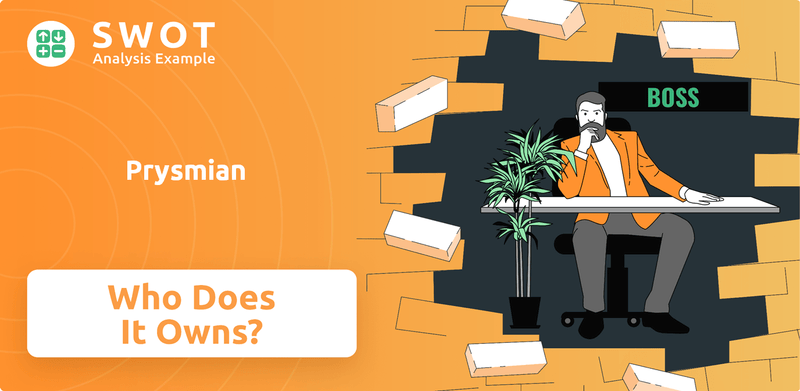
This deep dive into Prysmian ownership will reveal the key players shaping the company's destiny. We'll explore the evolution of Prysmian Group, tracing its journey from its roots to its current standing as a publicly traded entity. Get ready to uncover the dynamics behind Who owns Prysmian and how it impacts this industry leader's performance, including its impressive Prysmian Group financial performance.
Who Founded Prysmian?
The story of Prysmian Group, a global leader in the cable industry, begins with its roots in Pirelli Cavi e Sistemi, the cable division of Pirelli, established in Italy in 1879. While the specific founders of the cable division and their initial equity are not readily available, the early years were marked by significant involvement in national infrastructure projects.
Key figures like Emanuele Jona and Luigi Emanueli played crucial roles in the early development of Pirelli's cable business. Emanueli notably developed oil-filled cables for power transmission between 1917 and 1924, showcasing early innovation. This initial phase laid the groundwork for what would eventually become Prysmian Group, highlighting its historical ties to major industrial advancements.
The evolution of Prysmian's ownership structure is a key part of its history. The company's transformation from a division within Pirelli to an independent entity marks a significant shift in its corporate journey. This transition involved strategic decisions that shaped its future as a global player in the cable industry.
Prysmian Group's origins trace back to the cable division of Pirelli, founded in 1879. Early projects included submarine telegraph cables for military use.
Emanuele Jona and Luigi Emanueli were instrumental in the early development. Emanueli's innovation included oil-filled cables for power transmission.
In 2005, Goldman Sachs Capital Partners acquired Pirelli & C. S.p.A.'s Cables and Systems business. This led to the creation of Prysmian S.r.l.
The acquisition by Goldman Sachs was valued at €1.3 billion. Goldman Sachs provided €225 million, with the rest financed by debt.
Valerio Battista became CEO after the acquisition, guiding Prysmian through its transition. The goal was to become a public company.
The strategic aim was to become a public company, avoiding a single controlling shareholder. This move was key after the buyout.
The acquisition by Goldman Sachs in 2005 marked a pivotal moment in the history of Prysmian. The company's transformation from a division within Pirelli to an independent entity was a strategic move aimed at enhancing its market position and operational flexibility. The initial funding structure, involving both equity and debt, set the stage for its future financial strategies. This change in ownership structure was key to the company's growth.
- Who owns Prysmian: Prysmian Group is a publicly traded company. The ownership is distributed among various institutional investors and the public.
- Prysmian shareholders: Major shareholders include institutional investors. The company's shares are listed on the Italian Stock Exchange.
- Prysmian history: Prysmian Group's history is closely tied to the evolution of Pirelli's cable division. The transition to an independent entity was a strategic move. Read more about the Growth Strategy of Prysmian.
- Is Prysmian a publicly traded company: Yes, Prysmian Group is listed on the Italian Stock Exchange.
Prysmian SWOT Analysis
- Complete SWOT Breakdown
- Fully Customizable
- Editable in Excel & Word
- Professional Formatting
- Investor-Ready Format
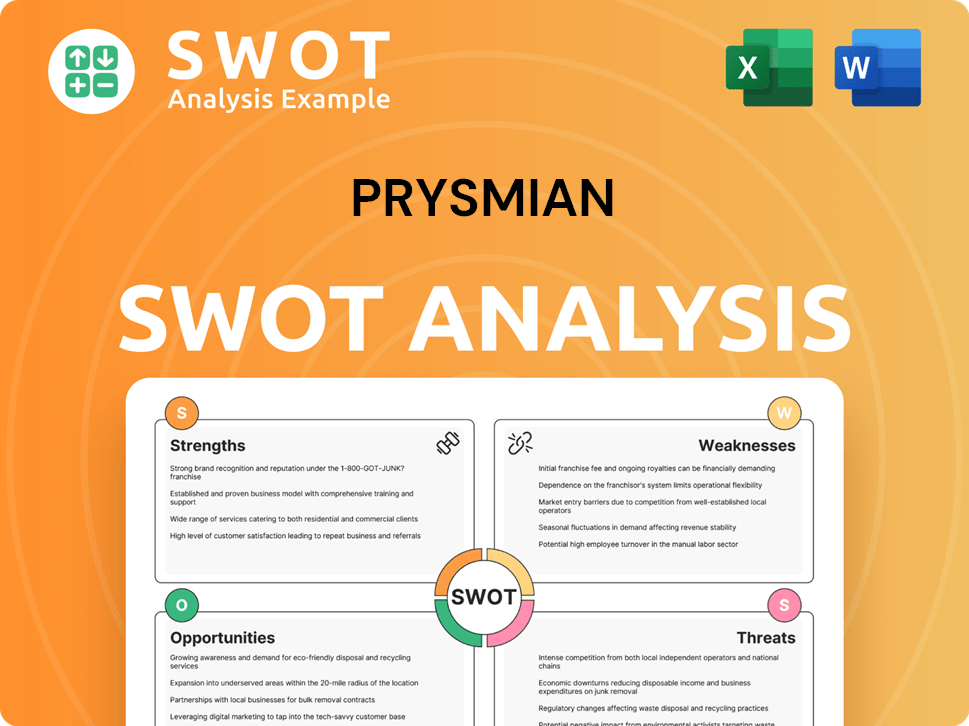
How Has Prysmian’s Ownership Changed Over Time?
The journey of Prysmian Group from a private entity to a publicly traded company is a key aspect of its Prysmian ownership structure. The company went public on the Milan Stock Exchange on May 3, 2007. Initially, Goldman Sachs Group held a significant stake, approximately 46% of the shares. This initial ownership structure was a pivotal moment in the Prysmian history.
Goldman Sachs Group's decision to fully divest its stake by March 2010 marked a significant shift. This transition made Prysmian Italy's first fully public company without a controlling shareholder. This strategic move underscored a commitment to long-term value creation, enhanced transparency, and robust corporate governance. The evolution of Prysmian's ownership reflects its adaptation to market dynamics and its dedication to shareholder value.
| Key Event | Date | Impact |
|---|---|---|
| Initial Public Offering (IPO) | May 3, 2007 | Transitioned Prysmian to a publicly traded company, increasing its visibility and access to capital. |
| Goldman Sachs' Divestiture | Completed by March 2010 | Transformed Prysmian into Italy's first fully public company without a controlling shareholder, promoting broader shareholder engagement. |
| Share Buy-Back Program | Concluded by February 28, 2025 | Reduced the outstanding shares, increasing the ownership stake of existing shareholders. |
As of February 28, 2025, Prysmian held approximately 3.25% of its share capital as treasury shares, totaling 9,625,273 shares, following the conclusion of a share buy-back program. The company's commitment to shareholder value is evident in its financial strategies. On April 22, 2024, the company had a free float equal to 100% of outstanding shares and a market capitalization of €13.7 billion. This demonstrates the company's robust financial health and its ability to attract and retain investors. For more insights, you can explore the Competitors Landscape of Prysmian.
Prysmian's ownership structure is designed to create value for its diverse shareholder base. The company focuses on enhancing shareholder remuneration through improved dividends.
- Commitment to long-term profitability and growth.
- Emphasis on transparency and corporate governance.
- Robust financial structure supported by strong cash generation.
- Strategic focus on shareholder value creation.
Prysmian PESTLE Analysis
- Covers All 6 PESTLE Categories
- No Research Needed – Save Hours of Work
- Built by Experts, Trusted by Consultants
- Instant Download, Ready to Use
- 100% Editable, Fully Customizable
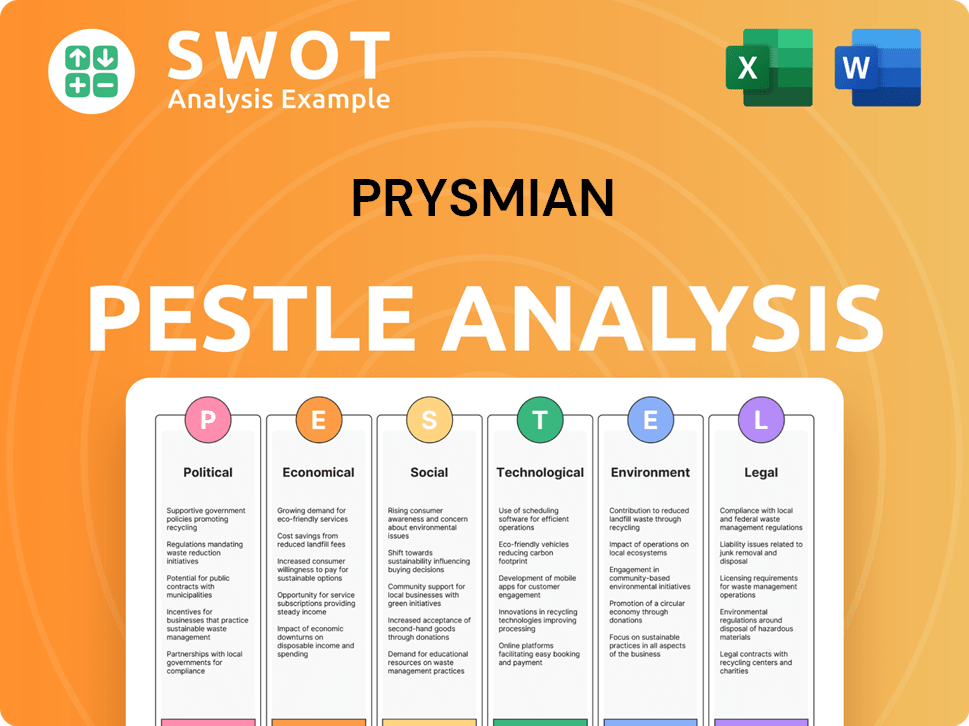
Who Sits on Prysmian’s Board?
The current board of directors of Prysmian Group plays a crucial role in its governance. The company operates within a framework designed for a publicly-held structure, with a focus on transparency. While specific details about individual board members and their exact representation of major shareholders are not explicitly detailed, the company emphasizes its commitment to corporate governance. For a deeper dive into the operational aspects, you can refer to the article on Revenue Streams & Business Model of Prysmian.
Prysmian operates under a one-share-one-vote structure, which is standard for publicly traded companies with dispersed ownership. The elimination of the nominal value of Prysmian shares, approved by the Shareholders' Meeting on April 16, 2025, reflects an effort to streamline its capital structure. The company's remuneration policy, including the CEO's compensation, is subject to detailed analysis and shareholder approval, as outlined in the 2025 Policy, approved by the Board on March 12, 2025. This highlights a strong emphasis on accountability to shareholders regarding executive compensation.
| Aspect | Details | Relevance |
|---|---|---|
| Governance Structure | Publicly traded with dispersed ownership | Ensures broad shareholder influence |
| Voting Rights | One-share-one-vote | Provides equitable voting power |
| Share Value | Nominal value eliminated (April 2025) | Simplifies capital structure |
The company's approach to shareholder engagement and executive compensation demonstrates a commitment to maintaining a transparent and accountable corporate environment. This is further supported by the detailed disclosure of the 2025 Remuneration Policy, which was approved by the Board on March 12, 2025, and is available to shareholders. The focus is on ensuring that the company's governance practices align with best practices for publicly-traded corporations.
Prysmian Group's governance structure emphasizes shareholder rights and transparency. The one-share-one-vote system ensures equitable voting power for all shareholders. The company's commitment to transparent disclosure and shareholder approval of executive compensation reflects a strong focus on accountability.
- One-share-one-vote structure.
- Shareholder approval of executive compensation.
- Commitment to transparency and disclosure.
- Streamlined capital structure.
Prysmian Business Model Canvas
- Complete 9-Block Business Model Canvas
- Effortlessly Communicate Your Business Strategy
- Investor-Ready BMC Format
- 100% Editable and Customizable
- Clear and Structured Layout
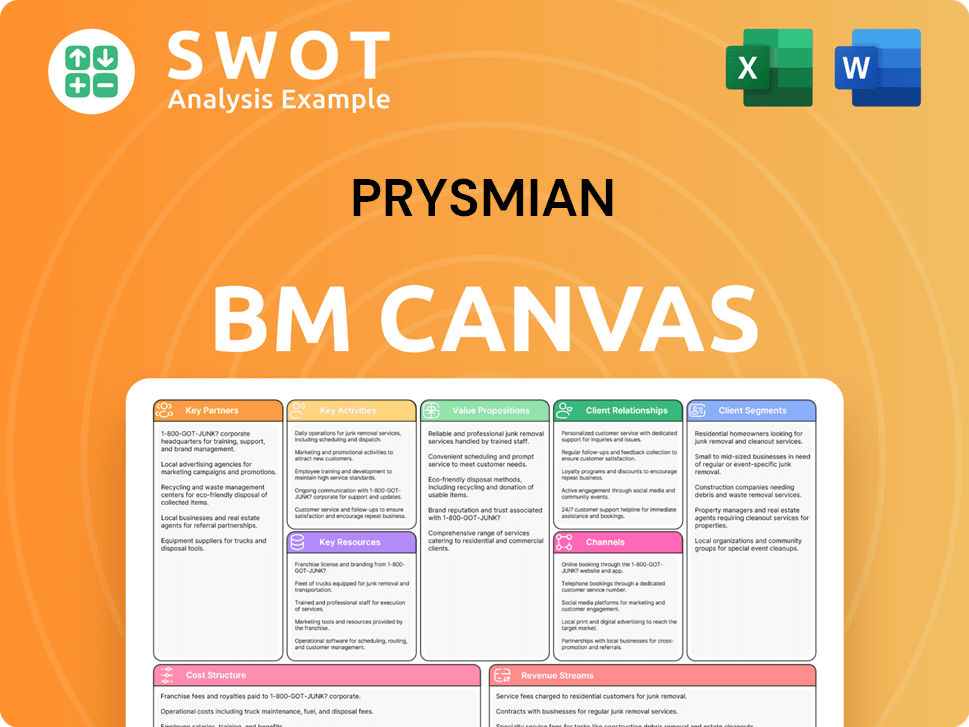
What Recent Changes Have Shaped Prysmian’s Ownership Landscape?
In the past few years, Prysmian Group has made significant moves impacting its ownership and market position. The acquisition of Encore Wire, a U.S.-based cable manufacturer, was a major development. This acquisition, finalized on July 2, 2024, for approximately $4.2 billion (€3.9 billion), strengthened its leadership in North America and globally. This strategic move aimed to capitalize on growth opportunities in digitalization and energy infrastructure. The deal was financed through a mix of cash (€1.1 billion) and new debt facilities (€3.4 billion).
Following the acquisition, Encore Wire became a privately held company, ceasing to be listed on NASDAQ. Additionally, Prysmian executed a share buy-back program of up to €375 million. This program ran from June 10, 2024, until February 28, 2025, when it reached its maximum value. By the end of the program, the company had purchased a total of 6,101,140 shares, representing approximately 3.25% of Prysmian's share capital. These actions reflect strategic adjustments in the company's ownership structure.
Industry trends, such as increased institutional ownership and consolidation, are evident in Prysmian's strategy. The company is actively pursuing a 'Value4All' program, launched in 2023, aimed at promoting share ownership among its employees, with a target of at least 50% employee shareholding by 2027. By the end of 2024, employee shareholding had reached 46%. This initiative aligns with Prysmian's social ambition and aims to enhance value generation and distribution. Public statements from the company, including its Capital Markets Day in March 2025, highlight its strong financial structure and ongoing commitment to profitable and sustainable growth, with plans to share new targets. For further insights into the company's strategic positioning, consider exploring the Target Market of Prysmian.
The acquisition of Encore Wire for approximately $4.2 billion (€3.9 billion) was completed on July 2, 2024. This was the largest acquisition in Prysmian's history.
A share buy-back program of up to €375 million ran from June 10, 2024, to February 28, 2025. The company purchased a total of 6,101,140 shares.
Prysmian aims for at least 50% employee shareholding by 2027. Employee shareholding reached 46% by the end of 2024.
Prysmian is focused on profitable and sustainable growth. The company highlights its strong financial structure and ongoing commitment.
Prysmian Porter's Five Forces Analysis
- Covers All 5 Competitive Forces in Detail
- Structured for Consultants, Students, and Founders
- 100% Editable in Microsoft Word & Excel
- Instant Digital Download – Use Immediately
- Compatible with Mac & PC – Fully Unlocked
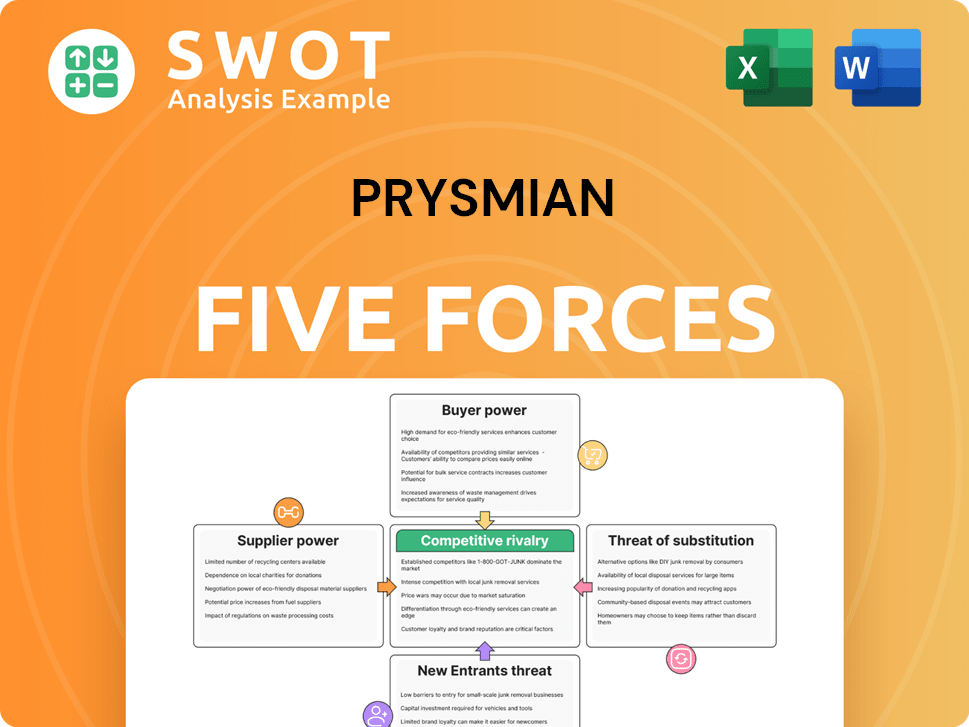
Related Blogs
- What are Mission Vision & Core Values of Prysmian Company?
- What is Competitive Landscape of Prysmian Company?
- What is Growth Strategy and Future Prospects of Prysmian Company?
- How Does Prysmian Company Work?
- What is Sales and Marketing Strategy of Prysmian Company?
- What is Brief History of Prysmian Company?
- What is Customer Demographics and Target Market of Prysmian Company?
Disclaimer
All information, articles, and product details provided on this website are for general informational and educational purposes only. We do not claim any ownership over, nor do we intend to infringe upon, any trademarks, copyrights, logos, brand names, or other intellectual property mentioned or depicted on this site. Such intellectual property remains the property of its respective owners, and any references here are made solely for identification or informational purposes, without implying any affiliation, endorsement, or partnership.
We make no representations or warranties, express or implied, regarding the accuracy, completeness, or suitability of any content or products presented. Nothing on this website should be construed as legal, tax, investment, financial, medical, or other professional advice. In addition, no part of this site—including articles or product references—constitutes a solicitation, recommendation, endorsement, advertisement, or offer to buy or sell any securities, franchises, or other financial instruments, particularly in jurisdictions where such activity would be unlawful.
All content is of a general nature and may not address the specific circumstances of any individual or entity. It is not a substitute for professional advice or services. Any actions you take based on the information provided here are strictly at your own risk. You accept full responsibility for any decisions or outcomes arising from your use of this website and agree to release us from any liability in connection with your use of, or reliance upon, the content or products found herein.